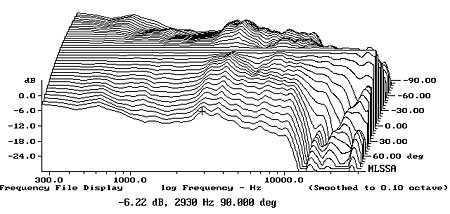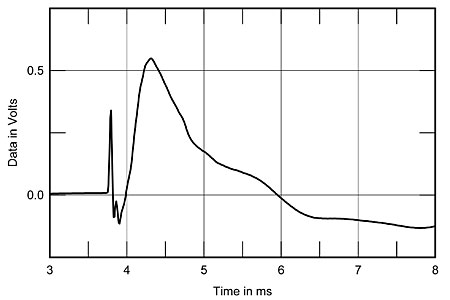| Columns Retired Columns & Blogs |
Chario Premium 1000 loudspeaker Measurements
Sidebar 3: Measurements
With its small enclosure and woofer, the Chario Premium 1000 won't have a high voltage sensitivity; specified at 86dB, its measured B-weighted sensitivity was 84.7dB(B)/2.83V/m, which is lower than average. The Chario's impedance magnitude remained above 8 ohms in the bass and treble, though it did drop to 5.4 ohms at 220Hz (fig.1). The electrical phase angle reaches extreme values in the upper bass, but fortunately, as is always the case, the highest angle coincides with a very high magnitude, which will mitigate any drive difficulty at this frequency. The fact that the impedance stays above 12.5 ohms in the treble will result in a bright tonal balance if the Premium 1000 is used with a tube amplifier having a typically high source impedance.

Fig.1 Chario Premium 1000, electrical impedance (solid) and phase (dashed). (5 ohms/vertical div.)
A discontinuity can be seen just below 700Hz in both impedance traces, which suggests the existence of some kind of cabinet resonance at that frequency. Investigating the panels' vibrational behavior with a simple plastic-tape accelerometer did uncover a very strong resonant mode on both sidewalls at 630Hz (fig.2). This may well be sufficiently high in frequency and of high enough Q to have no degrading effect on the speaker's sound, especially when the small radiating area of the affected panel is taken into consideration.

Fig.2 Chario Premium 1000, cumulative spectral-decay plot calculated from output of accelerometer fastened to center of side panel (MLS driving voltage to speaker, 7.55V; measurement bandwidth, 2kHz).
All the acoustic measurements were performed with the Premium 1000's grille removed. The saddle between 50 and 60Hz in the impedance-magnitude plot (fig.1, solid trace) suggests that this is the tuning frequency of the downward-firing port. The blue trace in the left portion of fig.3 shows the woofer's nearfield response, and it does indeed have the expected minimum-motion notch at 56Hz. The port's output (red trace) smoothly peaks between 40 and 90Hz, and though some peakiness is evident in the upper midrange, this is well down in level. The sum of the LF responses, taking into account both acoustic phase and the different distances of the woofer cone and port from a nominal farfield microphone position, is shown as the black trace below 300Hz in fig.3. The broad peak in the upper bass will be almost entirely due to the nearfield measurement technique; the Premium 1000 is basically flat to around 70Hz, with then the usual steep rollout of a reflex design. Bob Reina called it correctly: no low bass, but well-defined mid- and upper bass.

Fig.3 Chario Premium 1000, anechoic response on tweeter axis at 50", averaged across 30° horizontal window and corrected for microphone response, with nearfield woofer (blue) and port (red) responses plotted below 300Hz and 1kHz, respectively, plus complex sum of nearfield responses (black).
Higher in frequency in fig.3 is a suspicious-looking bump in the midrange response between 600 and 800Hz; suspicious because this is the region where the cabinet sidewalls had their resonance. However, BJR didn't comment on any lack of midrange clarity that would have resulted from this behavior. The treble is basically smooth and flat, though there is a definite step down from the woofer to the tweeter in the crossover region that, all things being equal, might make the Chario sound a bit laid-back.
However, the Premium 1000's lateral-dispersion plot (fig.4) reveals that the trough in the presence region fills in to the speaker's sides. The perceived treble balance will therefore depend on the exact degree of toe-in, as BJR found. This graph also indicates that the tweeter becomes extremely directional above 10kHz, which will make the Chario sound lacking in top-octave air in all but very lively rooms. Bob did say that he "didn't get the impression that the Premium 1000's highs were particularly extended," with violin lacking "extreme top-end sparkle"—which is what I would have expected, given this graph. In the vertical plane (fig.5), a suckout in the crossover region develops more than 20° above and below the tweeter axis, but the speaker is generally not too critical regarding exact listening axis.

Fig.4 Chario Premium 1000, lateral response family at 50", normalized to response on tweeter axis, from back to front: differences in response 90–5° off axis, reference response, differences in response 5–90° off axis.

Fig.5 Chario Premium 1000, vertical response family at 50", normalized to response on tweeter axis, from back to front: differences in response 45–5° above axis, reference response, differences in response 5–45° below axis.
The Premium 1000's step response on the tweeter axis (fig.6) indicates that both drive-units are connected in positive acoustic polarity, with the tweeter's output just a little too far ahead of the woofer's for optimal integration on this axis. Though a slight ridge of delayed energy associated with the upper-midrange step in the woofer's output can be seen in the cumulative spectral-decay plot (fig.7), the region covered by the tweeter shows an impressively clean decay.

Fig.6 Chario Premium 1000, step response on tweeter axis at 50" (5ms time window, 30kHz bandwidth).

Fig.7 Chario Premium 1000, cumulative spectral-decay plot on tweeter axis at 50" (0.15ms risetime).
Overall, the Chario Premium 1000 demonstrates good technical performance, though care should be taken in setup to optimize its mid-treble balance.—John Atkinson
- Log in or register to post comments




































